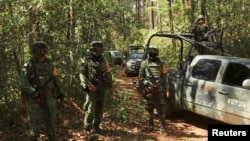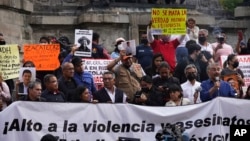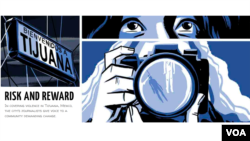After the safe return of two Mexican journalists kidnapped in a stronghold of a drug cartel, concerns focus on their colleague who is still missing.
An operation involving the military and National Guard led to the release of Jesus Pintor Alegre and Fernando Moreno Villegas this week, the Guerrero state prosecutor's office said.
The status of their colleague Alan Garcia Aguilar is unclear. All three disappeared more than two weeks ago in southern Guerrero state, one of Mexico's most violent regions.
"Since it became aware of the disappearance, this office started an operation in coordination with personnel from the Army and the National Guard and State Public Security in various points of the region, which influenced the fact that the probable perpetrators released these people," the prosecutor's office said in a statement.
The journalists work for the news website Escenario Calentano, which regularly publishes stories about the Familia Michoacana drug cartel, which operates in the region.
Earlier this week a chilling video of Moreno and Garcia was posted on social media, showing them chained hand and foot.
In the 41-second clip, Moreno stated that they were "paying the consequences of the publications against those people in the region of Tierra Caliente and Guerrero of Mexico."
A message, possibly from the kidnappers, accompanies the video and says in part, " ... so that they see it is true, we are going to publish this video from their page."
Mexico remains one of the most dangerous countries in the world in which to be a journalist, with killings, threats and kidnappings common. Media watchdogs say the country saw its most deadly year on record last year for journalists, with UNESCO recording 19 killings.
Hours after Pintor was released, he called on Mexican President Andres Manuel Lopez Obrador, known as AMLO, to change the country's policy to tackle the endemic problem of kidnapping by drug gangs of journalists and human rights activists.
" 'Hugs, not bullets' does not work, and the population lives in a state of barbarism, totally unprotected," Pintor told Radio Formula, a local station.
The president's "hugs, not bullets" policy has involved tackling the social causes of drug violence and reducing the military presence on the streets.
It has been widely criticized because it has not resulted in a decline in murders related to drugs gangs.
Pintor said he was kidnapped on the morning of December 27. Individuals blindfolded him and put him in a vehicle. From there he was driven to an unknown destination and questioned about his work for the website. Moreno and Garcia were kidnapped separately.
Pintor said he was released without explanation near the Cuirio River near Coyuca de Catalan.
Journalists from the state of Guerrero appealed for their colleagues' safe release in a letter to the heads of the federal and state governments, the Attorney General's Office and the National and State and Human Rights Commission.
The state's human rights commission and international rights groups also made appeals for the authorities to "find the journalists immediately" and to provide protection for relatives and other media workers in the region.
Jan-Albert Hootsen, the Mexico representative of the Committee to Protect Journalists (CPJ), which had called for their release, said Friday that he was still trying to reach the families of the journalists.
Victims being released "is a pretty unusual situation in terms of journalists being kidnapped in Mexico. Usually, the outcome is not such good news," he told VOA.
"This seems to have happened because of the local and international media attention which this case attracted. But we cannot say this means that the outcome in other cases will also be the same. This was a very local situation."
Paula Saucedo, of the media rights group Article 19, told VOA that the website the journalists worked on mainly reported stories about the Familia Michoacana drug cartel.
"It is a very dangerous area where they work. It is not somewhere where much reliable information comes out because of the security situation and the organized crime," she added.
Balbina Flores, of media watchdog Reporters Without Borders, told Agence France-Presse that the region where the kidnapping took place is a dangerous area "controlled almost 100% by the Familia Michoacana cartel."
Vicente Calderon, a journalist based in Tijuana state who has worked on stories about challenges for the press, including for VOA, said media professionals are at risk in many parts of the country.
"Here in Tijuana, where I am, there's a lot of people fleeing that state due to the lack of security," he told VOA.
Two well-known journalists were killed in Tijuana in January 2022.
Human Rights Watch World Report for 2023, published Thursday, found Mexico remained one of the most dangerous countries in the world for journalists and that authorities did little to track down those who attack them.
"Authorities routinely fail to investigate crimes against journalists adequately. The federal special prosecutor's office to investigate crimes against journalists had opened 1,552 investigations and obtained 32 convictions, including seven for homicide, from its creation in 2010 to September 2022," the report said.
Last month, one of the country's best-known television news presenters said that he had survived an apparent assassination attempt in Mexico City.
Ciro Gomez Leyva said two people on a motorbike shot at him while he was traveling in his armored vehicle, but he escaped unharmed.
Authorities in Mexico City announced this week that 11 suspected gang members had been arrested in connection with the attack on Gomez.
Some information for this report came from Agence France-Presse.







